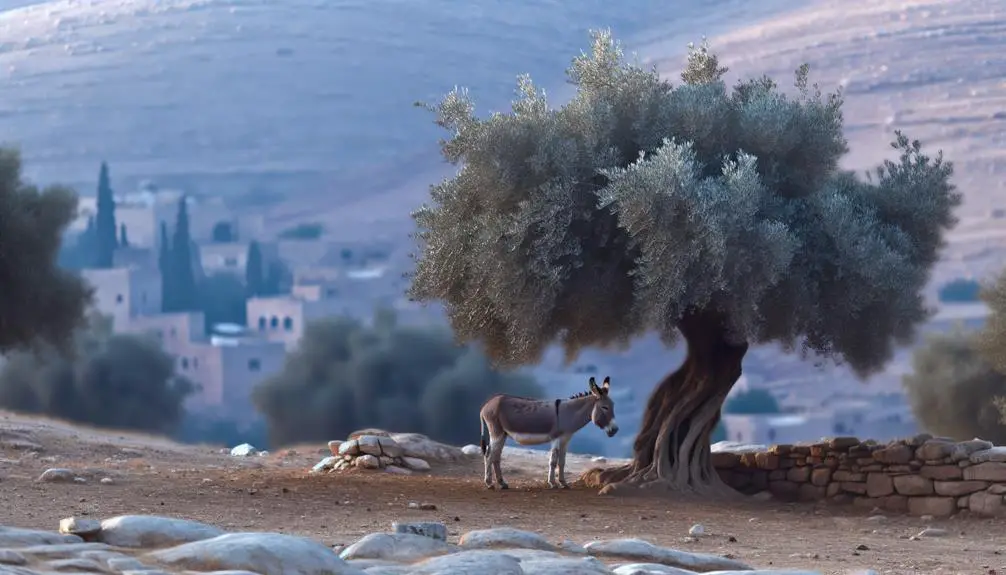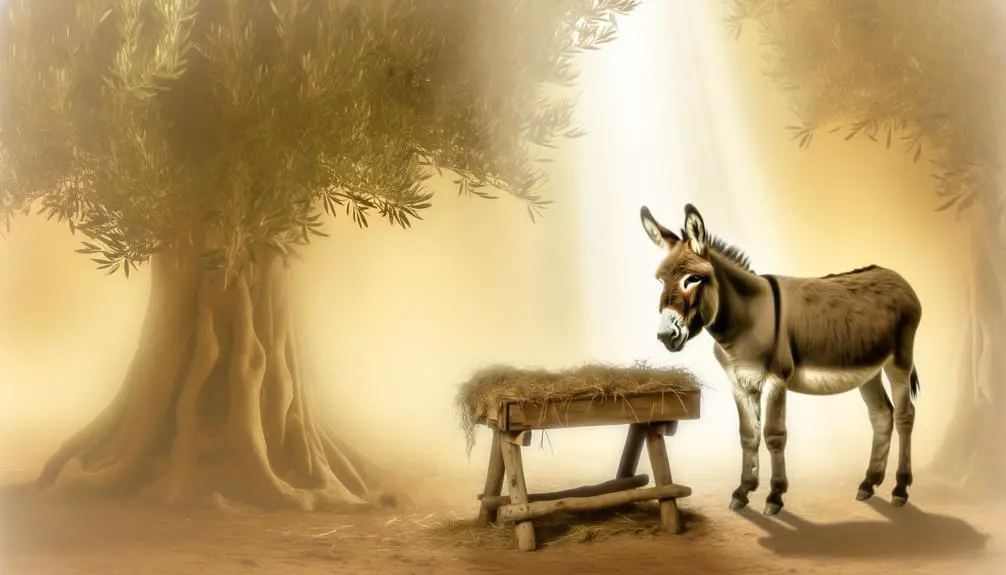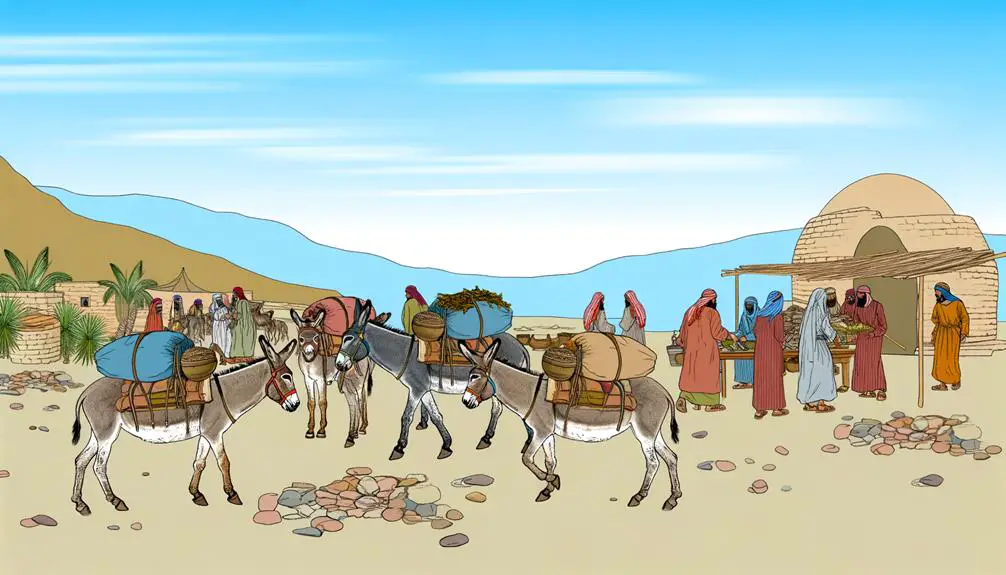Marvel at the symbolic roles of donkeys in the Bible, where their humble service unravels divine mysteries and profound lessons.

Donkeys in the Bible
In the Bible, you'll notice that donkeys are depicted not just as common beasts of burden, but as symbolically significant creatures embodying service and humility. These animals play important roles in prophetic messages, from Balaam's talking donkey, which showcases divine intervention and communication with humanity, to their part in the Flight to Egypt, fulfilling ancient prophecies. Donkeys in the Bible challenge you to reflect on virtues like humility and obedience. Their narrative involvement moves beyond mere transportation, becoming instruments in divine plans and symbols of peace. Exploring their layered roles might surprise you with deeper insights into biblical themes.
Key Takeaways
- Donkeys symbolize humility and service, evident in their frequent use for transportation and burdens in biblical stories.
- Balaam's talking donkey represents divine intervention and challenges notions of obedience and communication in scripture.
- The humble donkey played a crucial role in the Flight to Egypt, signifying divine protection and fulfillment of prophecies.
- Donkeys are depicted as essential in warfare and logistics, providing strategic advantages and maintaining supply chains.
- In various parables and teachings, donkeys illustrate themes of mercy, unexpected heroism, and prophetic significance.
Significance of Donkeys in Scripture

Donkeys hold a profound symbolic role in biblical texts, often representing service and humility. Their depiction throughout scripture not only highlights their physical burdens but also enriches the spiritual and prophetic narratives found within these sacred texts. The donkey's burdens are emblematic of servitude; they're often seen carrying loads too heavy for humans, symbolizing the weight of spiritual and moral obligations that believers are called to bear.
In the domain of donkey prophecies, one significant appearance is in the Old Covenant, where donkeys are interwoven with the destinies of nations and individuals. These prophecies use the donkey as a symbol to convey deeper truths. For example, a king riding a donkey, as opposed to a horse, symbolizes peace rather than conquest. This image not only fulfills specific prophecies but also serves to underscore a message of humility and peace, contrasting with the prevailing symbols of power and war.
Thus, when you look beyond the surface, the biblical donkey isn't just a beast of burden but a key player in the unfolding of divine messages. Their presence in scripture challenges you to ponder the virtues of humility and service, essential for spiritual enlightenment and growth.
Balaam's Talking Donkey
One of the most intriguing episodes in the Bible involves Balaam's donkey, which miraculously speaks to prevent its master from proceeding on a perilous path. This narrative, found in Numbers 22:21-35, exemplifies a profound instance of divine intervention and animal communication. You'll notice that the text doesn't merely portray the donkey as an instrument of speech but as a sentient being capable of perceiving spiritual entities invisible to Balaam himself.
Analyzing this episode, understanding the context in which this divine intervention occurs is crucial. Balaam, a prophet, is en route to curse the Israelites at the behest of Balak, king of Moab. God sends an angel to obstruct Balaam's path, visible only to the donkey. After Balaam beats the donkey for refusing to move, the animal is given a voice by God to articulate its pain and perception, highlighting a moral about the spiritual blindness of humans in contrast to the supposed 'beasts.'
This narrative challenges typical perceptions of hierarchy and cognition between humans and animals. It serves as a theological reflection on obedience, the ethics of perception, and the broader implications of communication between divinity and humanity through unconventional mediums.
The Flight to Egypt

In the biblical narrative, Joseph's urgent night-journey to Egypt with Mary and Jesus, often termed the 'Flight to Egypt,' embodies a pivotal moment of divine intervention and prophetic fulfillment. This segment of scripture highlights the protective transport provided by the donkey, ensuring Mary's journey to Egypt was both safe and feasible under the cover of darkness. The donkey, often overlooked, emerges as a silent bearer of salvation, carrying the young Messiah and his parents away from imminent danger.
This event is not just a simple travel log but a complex interplay of prophecy, obedience, and divine provision. Consider the following points:
- Prophetic Alignment: The journey fulfills ancient prophecies, like Hosea 11:1, 'Out of Egypt I called my son,' underscoring the divinely orchestrated nature of this escape.
- Divine Intervention: The angel's warning to Joseph in a dream exemplifies direct divine action crucial for the safety of the Holy Family.
- Practical Necessity: The donkey's role as a mode of transport was practical, given the terrain and the urgency of the escape.
- Symbolic Significance: The humble donkey symbolizes the humility and earthiness of Christ's early life, juxtaposed with his divine origin and mission.
These elements together enrich our understanding of 'The Flight to Egypt,' revealing layers of theological and practical insights into how pivotal moments in biblical narratives are intricately woven with both divine and earthly concerns.
Donkeys in Ancient Warfare
As you explore the utilization of donkeys in ancient warfare, it's important to highlight their roles in battles and the strategic advantages they provided. These animals were not only used for transport but also played a critical role in supply chains, enabling armies to maintain logistical support over extended campaigns. The adaptability of donkeys to diverse terrains made them invaluable in the strategic deployment of forces across challenging environments.
Donkeys' Roles in Battles
How did donkeys, typically perceived as beasts of burden, play strategic roles in ancient military conflicts? You might not consider donkeys as frontline warriors, but their impact in warfare, particularly through donkey logistics and managing the military burden, was significant. These animals were indispensable for transporting supplies, moving equipment, and ensuring that armies could maneuver with the necessary provisions and armaments to maintain their campaigns.
- Transportation of Supplies: Donkeys carried food, water, and military gear, essential for long campaigns.
- Movement of Weapons: They were used to transport weaponry and armor, keeping the fighting forces equipped.
- Medical Support: Injured soldiers were often carried back from battlefields using donkeys.
- Communication: Donkeys sometimes carried messages or messengers across rough terrains.
Their endurance and ability to navigate difficult paths made them invaluable in maintaining the logistics that supported ancient military operations.
Strategic Advantages of Donkeys
Donkeys played a vital role in ancient warfare, greatly enhancing military mobility and supply chain efficiency. Their role in donkey logistics was pivotal. You'd find that these sturdy animals were not just beasts of burden, but essential in maintaining the flow of supplies, from food to weaponry, across varied terrains. This logistical support allowed armies to operate far from their bases, extending their reach and endurance in prolonged campaigns.
Furthermore, donkeys' agricultural roles indirectly supported military efforts. They were essential in plowing fields and transporting harvests, ensuring a steady supply of food for troops. This dual utility made them indispensable in both peacetime farming and wartime supply chains, bolstering an army's capacity to wage war effectively.
Symbolism of Humility and Service

Throughout history, donkeys have been emblematic of humility and service, serving not just as beasts of burden but also as profound symbols in biblical narratives. You'll find that their representation goes beyond mere utility, touching the spiritual and moral fibers of ancient texts. In the domain of biblical symbolism, the donkey's image as a humble servant is pivotal, grounding many stories in a reality that is accessible and universally relatable.
The donkey's humble service is a recurring motif in scripture, providing a tangible lesson in humility and the grace of modest living. Unlike horses, often symbols of war and wealth, donkeys are portrayed in a more modest and peaceful light, making their lessons particularly poignant. Here's how they contribute to the biblical narrative:
- Subtle Presence: Often in the background, donkeys are a quiet yet constant presence, symbolizing the strength found in gentleness.
- Bearer of Burdens: Emblematic of their role in society, donkeys carry loads too heavy for many, suggesting a spiritual analogy to bearing one's cross.
- Symbol of Peace: Their use by peaceful figures, like prophets, contrasts with the more militant horse, highlighting themes of pacifism.
- Connection to the Common Man: Donkeys are associated with the everyday person, bridging divine messages to the layman's experiences.
This layered symbolism enriches your understanding of biblical themes, making every mention of a donkey a potential reflection on deeper spiritual truths.
Donkeys in Parables and Teachings
In examining the role of donkeys in biblical parables and teachings, you'll find these creatures are not merely incidental. Consider the parable of the Good Samaritan, where the donkey is instrumental in demonstrating acts of mercy and compassion, or Balaam's talking donkey, which challenges our understanding of divine communication. Additionally, the return of the prodigal son subtly incorporates a donkey, symbolizing both a humble return and the father's unconditional acceptance.
Donkey in Good Samaritan
Within the parable of the Good Samaritan, the donkey serves a pivotal role, illustrating the practical means of compassion by transporting the wounded man to safety. You might ponder the significance of the donkey within this scenario, not just as a beast of burden, but as a symbol of servitude and mercy. The choice of the donkey, given its commonness in daily life and its utility in Samaritan travel, emphasizes the accessibility of compassionate acts; it's not the priest or Levite, but a Samaritan with a donkey who becomes the hero.
- Symbol of Humility: Represents modesty and service in contrast to social status.
- Donkey Ownership: Indicates economic status and societal roles during biblical times.
- Utility in Travel: Essential for practical tasks and transportation.
- Instrument of Mercy: Facilitates the Samaritan's act of kindness, bridging cultural and social divides.
Balaam's Talking Donkey
Rarely does a biblical tale capture the imagination as vividly as that of Balaam's talking donkey, which uniquely highlights communication between humanity and the divine. This narrative, found in the Book of Numbers, serves as a profound example of animal communication and miraculous intervention. You're invited to explore the details where a seemingly ordinary donkey becomes the mouthpiece for divine wisdom. This incident not only emphasizes the unexpected nature of divine messages but also critiques human perception of intelligence and speech within the natural world. The donkey, perceiving an angelic figure that Balaam himself cannot see, challenges conventional expectations about communication capabilities across species. This story intricately weaves theological themes with a critique of human arrogance and oversight.
Prodigal Son's Return
Reflecting on Balaam's donkey, we now turn to examine donkeys in the parable of the Prodigal Son, where their roles underscore themes of service and humility. In this parable, the donkey isn't just a beast of burden but symbolizes the journey of the Prodigal Son back to his father, laden with humility and repentance. The donkey carries him home, embodying the weight of his newfound humility and the anticipation of his father's forgiveness.
- Symbolic Carrier: The donkey facilitates the Prodigal's return, bearing not just his physical weight but his emotional and spiritual burdens.
- Unspoken Witness: It observes the unfolding of profound human emotions—repentance and unconditional love.
- Agent of Transformation: Reflects the shift from pride to humility in the Prodigal.
- Quiet Servitude: Represents service without seeking recognition, paralleling the father's forgiveness.
This layered portrayal enriches our understanding of the narrative's deeper meanings.
Prophetic Uses of Donkeys
Donkeys hold a significant role in biblical prophecy, often symbolizing humility and service amidst divine revelations. In examining donkey prophecies, one sees that these creatures are not merely background characters but pivotal to the unfolding of eschatological narratives. For instance, the Book of Zechariah (9:9) prophesies the coming of a just savior riding on a humble donkey, a clear prefiguration of Christ's entry into Jerusalem. This event intertwines the donkey with apocalyptic symbols, embodying peace as opposed to the war horse, symbolizing a shift from old conquests to a new era of salvation.
Furthermore, you'll find that the prophetic use of donkeys extends beyond mere symbolism. In Numbers 22, the narrative of Balaam's donkey, who speaks to prevent his misguided journey, serves not only as a miraculous intervention but also a prophetic act, reinforcing the theme of divine oversight and correction. This incident highlights how donkeys, often overlooked and undervalued, are chosen by God to enact critical moments of divine intercession and guidance.
Through these narratives, it's evident that donkeys are not just passive figures but are dynamically involved in the divine plan, bridging the heavenly and the earthly, urging a deeper reflection on their prophetic significance.
Cultural and Historical Context

As you explore the cultural and historical context of donkeys in the Bible, you'll find that their symbolic meanings are deeply embedded in ancient traditions. These animals were not merely beasts of burden; they held significant roles that reflected societal values and religious beliefs. Understanding these symbols provides insight into how communities viewed divinity and morality through the lens of everyday life.
Donkeys' Symbolic Meanings
Throughout history, the donkey's role has been imbued with significant symbolic meanings, often representing humility and service in various cultural contexts. You'll find that different donkey breeds have been selectively used in rituals, like donkey sacrifices, which highlight their importance in both mundane and sacred spheres. These practices offer a glimpse into how societies have valued donkeys not just for labor but also in symbolic terms.
- Humility: Donkeys are often portrayed as humble beasts, reflecting their modest presence and enduring workload.
- Service: Their role in agriculture and transportation underscores their symbolism in servitude and reliability.
- Sacrifice: Historically, donkeys were used in sacrificial ceremonies, symbolizing submission and atonement.
- Patience: They embody patience, often bearing burdens silently and with great endurance.
Donkeys in Ancient Traditions
In ancient societies, you'll find that donkeys were not merely beasts of burden but pivotal figures in various cultural rites and traditions. Their roles extended beyond mere agricultural labor. Donkeys were integral to farming practices, essential for plowing fields and transporting harvests, which underscored their value in sustaining communities.
Donkey burials, found in several archaeological sites, highlight their esteemed status. These burials, often with elaborate rituals, signify the donkey's importance beyond utility, hinting at a symbolic reverence.
Consider this table illustrating key aspects of donkeys in ancient traditions:
Aspect |
Detail |
Significance |
|---|---|---|
Agricultural Roles |
Plowing and transport |
Backbone of farming |
Burial Practices |
Ritualistic interments |
Cultural reverence |
Iconography |
Represented in art and lore |
Symbolic status in society |
Analyzing these elements sheds light on how intertwined donkeys were with the fabric of ancient life.
Donkeys in Festivals and Celebrations
Donkeys have played pivotal roles in various biblical festivals and celebrations, often symbolizing peace and humility. Their involvement isn't just a matter of convenience but deeply rooted in the cultural and religious contexts of the times. You'd find that these animals were not only practical with regard to celebration transport but also held significant festival roles, serving both symbolic and functional purposes.
In examining the scriptural accounts and historical backdrops, you'll notice:
- Transportation of Goods: Donkeys were primarily used to transport materials needed for festival preparations, such as food and decorations. This role was essential for ensuring that celebrations were stocked with the necessary supplies.
- Symbolic Entries: During important religious festivals, leaders often rode donkeys to symbolize peace, fulfilling prophecies and setting a tone of humility.
- Participation in Rituals: In some rites, donkeys were part of the ceremonial aspects, either in parades or as part of sacrificial practices, reflecting their integral role in the spiritual and communal life.
- Cultural Representation: They often represented common folk and their everyday struggles, bridging the gap between ordinary life and religious observance.
Understanding these roles enhances your appreciation of the donkey's multifaceted presence in biblical narratives, emphasizing their importance beyond mere beasts of burden.
Reflecting on Their Biblical Role

Reflecting on their role in biblical narratives, you'll see that donkeys weren't merely incidental characters but were pivotal to the unfolding of many scriptural events. The significance of donkeys in these stories isn't just a confirmation of their presence but highlights their integration into daily life and spiritual symbolism. Consider the implications of donkey domestication, a process that not only made these animals indispensable for agricultural and transportation needs but also ingrained them in the societal and economic frameworks of ancient civilizations. This domestication underscores their reliability and enduring presence across various biblical passages.
Moreover, the maintenance of donkeys speaks volumes about their value and the care they received. Maintaining a donkey was not simply about physical upkeep but ensuring that these animals could perform tasks that were often critical for survival and livelihood. Their robustness and resilience, necessary traits for the harsh environments they often navigated, also metaphorically mirrored the spiritual and physical journeys of the biblical figures who depended on them.
Thus, when you explore the biblical text, you're not just encountering a background element but a significant contributor to the narrative's progress. Their roles are both literal and symbolic, carrying not just people or goods, but significant theological and moral weight.
Frequently Asked Questions
How Many Times Are Donkeys Mentioned in the Bible?
You're exploring donkey symbolism and roles, yet without specific biblical context, it's challenging to pinpoint their significance. In scholarly terms, these figures are essential for understanding cultural and historical narratives within the text.
Did Donkeys Have Specific Names in Biblical Texts?
In biblical texts, donkeys didn't typically have specific names, reflecting their symbolic roles as humble servants. Their anonymity underscores their function over individual identity, aligning with broader themes of service and humility.
What Were the Feeding Practices for Donkeys in Biblical Times?
In ancient times, feeding practices for livestock included specific diets and rituals. You'd find that animals were typically given grains and vegetation, reflecting both their nutritional needs and the available agricultural resources.
Are Donkeys Depicted Differently in Other Religious Texts?
In exploring donkey symbolism across religious texts, you'll find varying representations. These differences often reflect broader theological themes and cultural values, enhancing your understanding of religious comparisons and symbolic interpretations of donkeys.
How Did Biblical Donkeys Influence Modern Perceptions of the Animal?
You might find that biblical donkeys have shaped modern views, lending symbolic interpretation and cultural reverence to the animal. Their roles in scripture often highlight humility and service, influencing contemporary attitudes toward donkeys.



Sign up